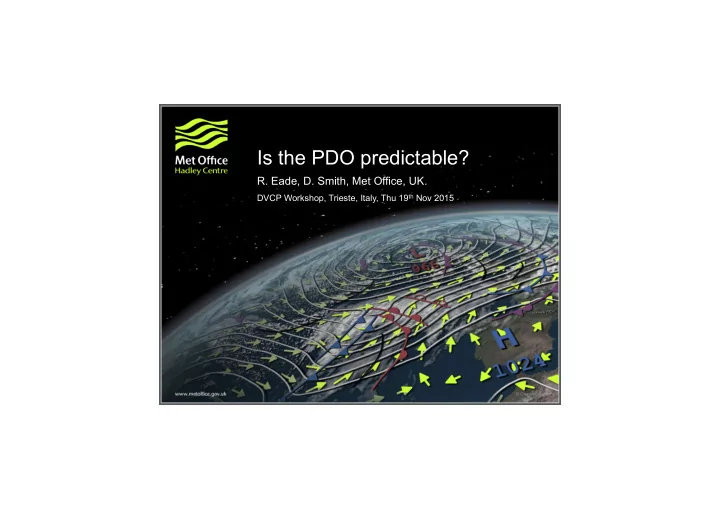

Is the PDO predictable? R. Eade, D. Smith, Met Office, UK. DVCP Workshop, Trieste, Italy, Thu 19 th Nov 2015
Many indices for Pacific Decadal Variability PDO EOFs calculated on North Pacific basin, 20-65N CMIP5 Models capture observed nodes in north Pacific & tropics. SAT: GMT removed PDV index (Dong et al, 2014) ( IPO ) Initialised decadal hindcasts Simpler transferable definition PDV: Tropical minus Northern Pacific area averages
Initialised SAT Decadal hindcasts (5-year means) have some skill for PDV indices EOF index PDV index Trop – N. Pac Some skill for PDO (r = 0.5) For EOF and two box definitions (SAT linearly detrended, grid box)
Single box averages from PDV 5-year mean NPAC after linearly detrending Init. Corr. 0.8 5-year mean TPAC after linearly detrending Init. Corr. 0.0 All model skill coming from northern Pacific box
Detrending artificially increases skill 5-year mean NPAC after linearly detrending Init. Corr. 0.8 5-year mean NPAC anomalies Init. Corr. 0.6 Removing linear trend on short period has added artificial cooling in northern Pacific that not physically there in the model Uninitialised model has same skill Skill artificially increased because obs have little trend in this period
Detrending SAT adding artificial skill Correlation 5-year mean SAT Initialised decadal hindcasts (a) Linearly detrended (b) Anomalies (c) a - b Generally correlation much greater with the trend Low correlation for tropical node of Pacific variability when SAT: GMT removed detrend But correlation has improved in North Pacific after detrending Unexpected and disconcerting as normally use detrending as a technique to assess skill beyond the trend
Detrending SAT adding artificial skill 5-year mean NPAC after linearly detrending Init. Corr. 0.8 External Forcing Experiments after linearly detrending Corr. 0.2 Corr. 0.6 Very different results if detrend over longer period (purple) Correlation drops from 0.6 (sig at 95%) for hindcast period to 0.2 for historical period
Initialised SAT Decadal hindcasts (5-year means) actual skill reduced for PDV indices EOF index Init. Corr. 0.42 PDV index Init. Corr. 0.34 Trop – N. Pac Some skill for PDO (r ~ 0.4) For EOF and two box definitions (SAT with GMT removed)
Aerosol & Natural forcings important (SAT GMT rm ) Correlation External Forcing ensembles 5-yr mean 1960s-present SAT Natural only SAT Aerosol only NPAC r = 0.5 (1960s+) Aerosol r = 0.10 Natural r = 0.3 (1960s+) r = 0.2 Ensemble mean variability beyond residual noise expected 5-95% s.d. expected from ensemble averaging (Av{Var[Mem]}/N)
Summary • Models capture Pacific variability EOF patterns very well • Moderate skill for PDV index when applied to linearly detrended SAT fields • Skill mainly in North Pacific rather tropical Pacific • But skill is artificially inflated by detrending à warning against linear detrending on too short a time period • Some signal from external forcing since 1960 Ø Anthropogenic aerosols Ø Natural factors (likely volcanoes) • Important to have realistic projections of Aerosol forcings to make forecasts
Recommend
More recommend